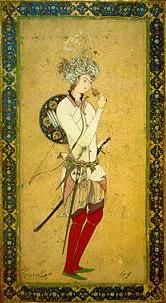History and Facts about Composite Bow
Composite bow is a type of traditional bow made of horn, wood, and sinew which are laminated together and is similar to the “laminated bow” which is made only of layers of wood. Most of the composite bows are recurve bows (when not stringed they curve opposite of the archer) that have wooden core with horn on the belly, facing the archer, and sinew on the back. Wooden core is made of multiple pieces, joined with animal glue in V-splices. Horn is used on the inside because it can store more energy than wood in compression. Sinew, placed on the back of the bow is soaked in animal glue. It is obtained from the lower legs and back of wild deer and is used because it will stretch farther than wood which again stores more power. Composite bows have smaller size and greater power than standard wooden bows which is the main reason for their existence and wide use.
We don’t know for sure who was the first to invent composite bow because not many bows have survived depths of time but we suspect that the first one were made by the nomads of the Asiatic steppe, who were inspired by the earlier Northern Asian laminated bows. Civilizations that came into contact with nomads, like Chinese, Assyrian, and Egyptian, took the idea of a composite bow and improved it further. Tomb of Tutankhamen, who died in 1324BC, held few surviving composite bows. Chinese Shang Dynasty (from 1700 to 1100BC) knew about composite bows and used them on war chariots. This bow was popular on chariots in other places as well until that combination was not replaced with mounted archers that still used composite bows. Infantry also used them and it was predominant long-distance weapon in Ancient Greece and Rome. Some armies even used composite crossbows like armies of the Han Dynasty (220BC to 206).
Although the basic principle was the same every civilization had its approach in design of the composite bow. Scythian bows were relatively short, had wooden core that was continuous from the centre to the tip and flexible tips. Bows with stiffened tips ("siyah") appeared in 4th century BC and became popular. The next improvement comes from Central Asian between 3rd and 2nd century BC. There were invented bows with stiffened grips with laths and stiff tips and were often asymmetric, with lower limb shorter than the upper. They were popularly called “Hun,” “Hunnic” or “Hsiung-nu” composite bows although other used them too. Turkish bows were probably the best traditional flight bows and were colored into multicolored designs with gold. Mongol bow was a recurved composite bow well-known for its military effectiveness. Its core was a bamboo, with layers of horn and sinew. Hungarian bow is a long, symmetrical, composite reflex bow with bone stiffeners. Korean Bow (Gungdo) is also a composite reflex bow but much smaller and made from water buffalo horn. It is used with a thumb draw. This bow is made bamboo, with sinew on the back, and oak for the handle. Isinglass glue holds it together. Sinew layer is covered with birch bark that is soaked in sea water for one year. Perso-Parthian bow is a symmetric recurve bow which endures high tension when strung and when it is unstrung its limbs cross each other.
We mentioned advantages of a composite bow but it is not perfect. It requires much more time for it to be made and animal glue that is used to hold its parts together can lose strength when exposed to moist of any kind. Because of that composite bow was more popular in dry or arid regions.
